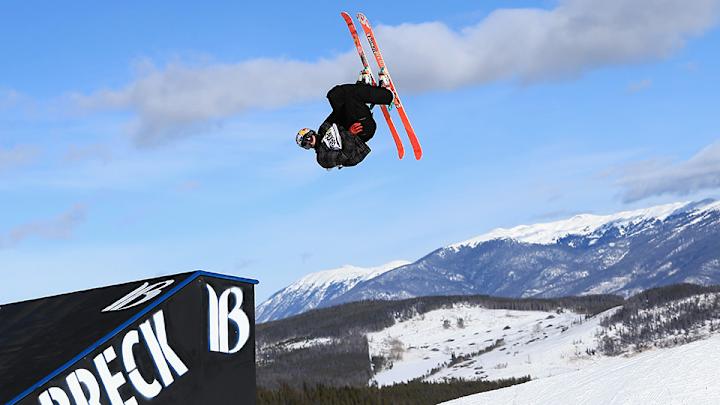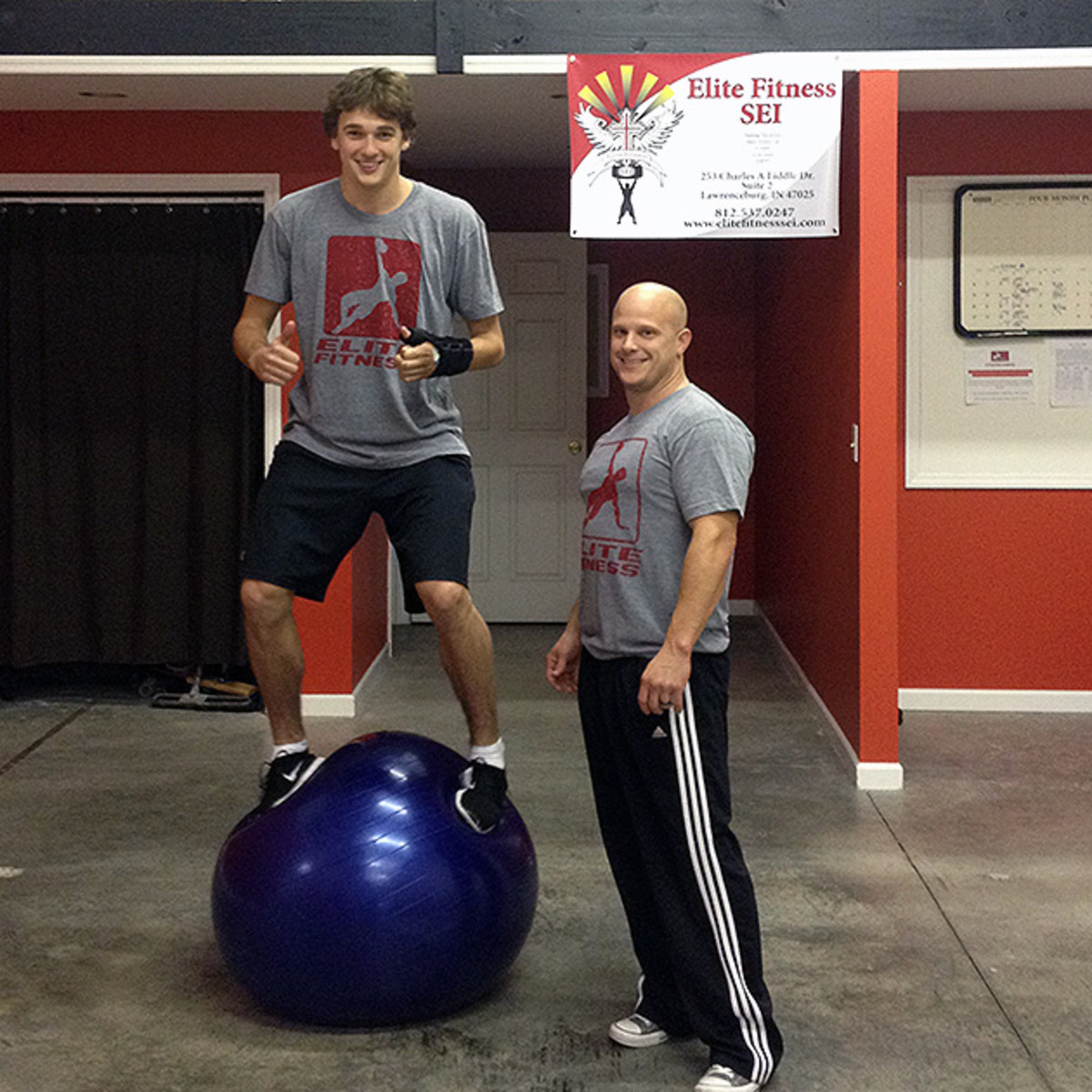Training with Nick Goepper: Inside his neuromuscular training, nutrition

During the competitive ski season, Olympic and X Games Slopestyle medalist Nick Goepper doesn’t like to tax his body more than his skiing already does. On a typical morning, he wakes at 7:30 a.m. and has a breakfast that more likely than not features steel cut oats, hard boiled eggs and/or a fruit salad. He’s out on the slopes by 9 a.m. and will stay out as late as 3 p.m., during which time he’ll get anywhere between 20 and 60 runs in, depending on his pace. After skiing, he comes home to a protein-based lunch—chicken and rice is a popular selection—and as the evening approaches, he starts his active recovery before a lean protein dinner.
“I’ll usually hop on the spin bike, do some stretching or some foam rolling and go to the steam room for active recovery, but I switch it up sometimes; I’ll also go trampoline jump and practice some flips and get that extra exercise in that way, or go skateboarding, which I love to do,” Goepper says, “I usually have a dinner similar to my lunch. I try to get my carbs, fats and protein in at every meal, lean meat like a lean steak or chicken, rice or quinoa, sweet potatoes and lots of nuts.”
Goepper doesn’t spend a lot of time in the gym during the season because he says the things that are most important to him—neurological strength, stability, flexibility and balance—don’t come from weightlifting. If he does go into the weight room, it’s because he has some extra time between skiing.
Stale Sandbech Q&A: Best Air+Style memories, learning new tricks, more
says. “I’ll do some maintenance, but won’t push myself too hard during the season because I think our bodies take enough abuse during the winter as is that pushing my body in a gym setting as well would be more detrimental than beneficial.”
According to Goepper, the competitive ski season lasts from late November to early April. In the spring, he takes time to rest and recover from the season passed. He hangs out with friends, goes on vacation; Goepper does the things that most young men his age like to do. In the summer, skiing in the southern hemisphere and glaciers in North America and Europe keeps him almost as busy as the ski season; the heavy workout months span from August to October, in preparation for the coming season.
“In times of heavier training closer to when the season begins, I’ll go to the gym once or twice a day. I still don’t lift a lot of heavy weights; I work on my neurological system a lot; my balance, body awareness, body control within different muscle groups, keeping the stabilizing muscles healthy,” Geopper says, echoing the teachings of his trainer. “At the end of the day, skiers who do flips are not really trying to build mass. We are trying to be as lean and in control of out bodies as possible.”
Geopper swears by neuromuscular training today, but that hasn’t always been the case. For all of Geopper’s success as one of the world’s top freeskiers–success that has seen him dominate the X Games and podium at the Olympics—at heart he’s still a kid from Lawrenceburg, Indiana. He travels the world for competition, but always comes home to Lawrenceburg when it calls. To this day, he still finds things in his hometown that help him on his lifelong journey. Local personal trainer Nick Story has been one of those treasures to Goepper. After their meeting in Fall 2013, the two changed the way Goepper exercised, which strengthened the foundation of the X Games three-peat that was to come and a ski career as long as it is fruitful.

When Goepper and Story met, the former was home in Lawrenceville nursing a broken hand suffered while skiing in New Zealand. Grounded by injury during the ski season, Goepper was looking to stay fit and got Story’s number from a man he goes to Sunday service with. Nick was in the early stages of a very important season; he was the defending X Games men’s ski Slopestyle gold medalist and a member of the U.S. ski team destined for Sochi. Goepper was looking for any way to keep his edge, and he found it in Story’s training methods.
“When I first met Nick, I believe he was coming to me from a crossfit gym. Crossfit is great, but it’s exercise culture that really doesn’t allow for athletes to specialize their workouts to their sport. That’s something top athletes need,” Story says. “Outside of some things on his own that are similar to elements of the program we developed for him, he’d never done anything like what we do. Certainly not with any guidance or direction.”
Chloe Kim Q&A: Inside the life and the fame of a snowboarding prodigy
would become his highest profile client.
When Story evaluated Goepper, he established that the skier would benefit from the neuromuscular intensification training that Story specializes in. The idea was to focus on strengthening Goepper’s stabilizing muscles instead of traditional weight lifting to help make Goepper’s body not just leaner, but smarter and better connected to the brain. Story started Goepper off with basic balancing exercises on the ground, and moved him onto weighted balancing exercises and exercise-ball training that had Goepper balancing free weights or his own weight on one foot or on exercise balls.
The pair worked together for a month during Goepper’s recovery in Indiana. After he returned to the circuit and competition, Goepper showed an improved ability to react to his skiing, whether it was executing a trick or saving a landing. That winter, he defended his X Games gold medal in the ski slopestyle event and won the bronze medal in Sochi as part of the third-ever U.S. sweep in an Olympic event. Goepper adopted Story’s training style after that season, and continues to follow it to this day. When circumstances brought Goepper back home again during the fall of 2015, he was back at Elite Fitness for six weeks coming into this season.
“It’s one thing to use someone for training, but it’s another thing to have someone who believes in you and believes in your mission. I think that makes a difference,” Geopper says. “It works the other way, too. It’s one thing to have a client, but it’s another to have a friend that you can push on a personal level. That’s what I like about it.”
Geopper doesn’t remember the heaviest weight he’s picked up. Story says the heaviest weight he’s seen Goepper work with was 115 pounds on a modified leg press machine. For Goepper, it’s not about weight. It’s not about strength. It’s about skiing. For that, 10 pounds and an exercise ball will beat triple digits on the bench press every time.
Neuromuscular Training Exercises
Hip Pendulum: One simple way to wake the nervous system up is to stand barefoot on one leg. With the other leg bent to 90 degrees and suspended, move the suspended leg from left to right in a pendulum fashion. Start with a minute, on each leg, on a stable surface. Once you can do a minute without touching the ground, use and unstable service to stand on (bosu, foam pad, pillow, etc.). Strengthens hip stability and over all balance.
Hamstring Curl: You will need a physiological ball also known as an exercise ball. Lying on your back on the floor, place your legs on top of the ball. With legs on the ball, lift your hips/buttocks off of the floor and pull your heels towards your buttocks. Do as many reps as you can with your hips off of the floor. Once you are able to do 30 reps without stopping, remove one leg and start doing a single leg hamstring curl on the ball. Strengths hamstring as well as whole core.
The SI Extra Newsletter Get the best of Sports Illustrated delivered right to your inbox
Subscribe
V-Up with ball: You will need a physiological ball. With your hands on the floor and the ball below your shins, raise your hips to the sky and try to get as inverted (upside down) as possible. Use your shoulders to help out with momentum, but try to get straight up and down (top of head parallel to floor). As you lower down keep your hips up and controlled. Don't sag the hips when you come down. Strengthens everything and can be very difficult.
